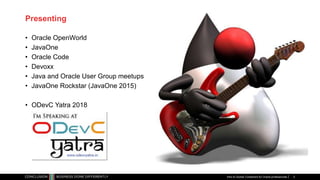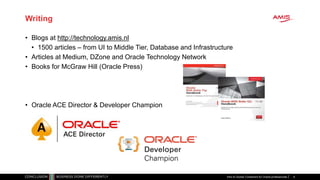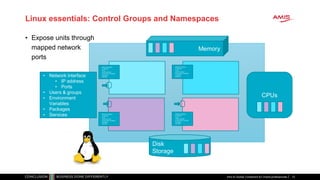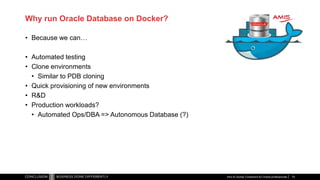Intro to Docker Containers and the Oracle Platform – Database, WebLogic &Cloud (ODevC Yatra 2018, July, Pune and Mumbai)
- 1. and the Oracle Platform - Database, WebLogic & the Cloud Intro to Docker Containers Intro to Docker Containers for Oracle professionals1 Lucas Jellema, CTO of AMIS ODevC Yatra, Pune, Friday 13th July 2018
- 2. Lucas Jellema Architect / Developer 1994 started in IT at Oracle 2002 joined AMIS Currently CTO & Solution Architect Intro to Docker Containers for Oracle professionals 2
- 3. Presenting • Oracle OpenWorld • JavaOne • Oracle Code • Devoxx • Java and Oracle User Group meetups • JavaOne Rockstar (JavaOne 2015) • ODevC Yatra 2018 Intro to Docker Containers for Oracle professionals 3
- 4. Writing • Blogs at http://technology.amis.nl • 1500 articles – from UI to Middle Tier, Database and Infrastructure • Articles at Medium, DZone and Oracle Technology Network • Books for McGraw Hill (Oracle Press) • Oracle ACE Director & Developer Champion Intro to Docker Containers for Oracle professionals 4
- 5. From The Netherlands Intro to Docker Containers for Oracle professionals 5
- 6. Setup for Oracle OpenWorld Demo What I needed • Local installation of a Kafka Cluster • At least one Broker node and the Zookeeper Kafka Broker Zookeeper Demo Application Intro to Docker Containers for Oracle professionals 6
- 7. Setup for Oracle OpenWorld Demo What I received from Guido • Simple text file – 140 lines Intro to Docker Containers for Oracle professionals 7 Name of Docker image to run Hostname on internal network between Docker containers Environment variable to pass to container Dependency on other container (to start first) Container port to expose externally
- 8. Setup for Oracle OpenWorld Demo What I created in a few minutes Intro to Docker Containers for Oracle professionals 8 Kafka Broker Zookeeper Kafka Rest ProxyKafka Schema Registry Kafka Connect Kafka Connect UI Kafka Schema Registry UI Kafka Manager 9092 2181 9000 8084 80018083 8081 8002
- 9. Some Quick Conclusions • Docker provides a great way to • Build environments (application & platform) (from simple, text based build files & public images) • Share & Ship these environments (either through build files or through ready-to-run images) • Run environments making efficient use of physical resources (that can be complex and have complex interdependencies) • And Guido is a very nice guy • And also: • [Docker] Containers are pivotal in cloud native environments, microservices architecture, DevOps and CD • Any IT professional should know her or his way around containers Intro to Docker Containers for Oracle professionals 9
- 10. Overview of today’s session • Docker Container – what and why? • Build, ship, run & operate • Use in development, training, testing, delivery and production & operations • Running custom containers on Oracle Container Cloud • Microservices and the application platform of tomorrow • Introducing Kubernetes and the upcoming Oracle Kubernetes Engine Cloud • Building Containers with Oracle platform from Oracle GitHub repo • Oracle Container Registry with prebaked images for Oracle platform • Going forward… Intro to Docker Containers for Oracle professionals 10
- 11. Linux essentials • Applications share resources Intro to Docker Containers for Oracle professionals 11 Disk Storage Memory CPUs Application A Application B Application C • Network interface • IP address • Ports • Users & groups • Environment Variables • Packages • Services
- 12. Linux essentials: Control Groups and Namespaces • Compartmentalize Resources into isolated units Intro to Docker Containers for Oracle professionals 12 Disk Storage Memory CPUs • Network interface • IP address • Ports • Users & groups • Environment Variables • Packages • Services Network interface IP address Ports Users & groups Environment Variables Packages Services Network interface IP address Ports Users & groups Environment Variables Packages Services Network interface IP address Ports Users & groups Environment Variables Packages Services Network interface IP address Ports Users & groups Environment Variables Packages Services
- 13. Linux essentials: Control Groups and Namespaces • Expose units through mapped network ports Intro to Docker Containers for Oracle professionals 13 Disk Storage Memory CPUs • Network interface • IP address • Ports • Users & groups • Environment Variables • Packages • Services Network interface IP address Ports Users & groups Environment Variables Packages Services Network interface IP address Ports Users & groups Environment Variables Packages Services Network interface IP address Ports Users & groups Environment Variables Packages Services Network interface IP address Ports Users & groups Environment Variables Packages Services
- 14. Linux essentials: Each unit runs its own processes • Units run their own processes: • OS (Linux) • Platform • Application Intro to Docker Containers for Oracle professionals 14 Disk Storage Memory CPUs • Network interface • IP address • Ports • Users & groups • Environment Variables • Packages • Services Network interface IP address Ports Users & groups Environment Variables Packages Services Network interface IP address Ports Users & groups Environment Variables Packages Services Network interface IP address Ports Users & groups Environment Variables Packages Services Network interface IP address Ports Users & groups Environment Variables Packages Services Application A Application B Application C
- 15. This stuff is complex • Core Linux features were hard to use Intro to Docker Containers for Oracle professionals 15 Disk Storage Memory CPUs• Network interface • IP address • Ports • Users & groups • Environment Variables • Packages • Services Network interface IP address Ports Users & groups Environment Variables Packages Services Network interface IP address Ports Users & groups Environment Variables Packages Services Network interface IP address Ports Users & groups Environment Variables Packages Services Network interface IP address Ports Users & groups Environment Variables Packages Services Application A Application B Application C
- 16. Docker has democratized Linux Containers • Container Image – a serialized file from which we can instantiate a container • Container Build script and workflow – to automate the creation of a container (image) using straightforward vocabulary • Engine – runtime platform for instantiating, running and managing containers, volumes and networks (REST API and CLI) • Docker Registry – Repository for Container Images • And now also Docker Store Intro to Docker Containers for Oracle professionals 16 Disk Storage Memory CPUs• Network interface • IP add res s • Por ts • Users & groups • Environment Variables • Packages • Services Network interface IP address Ports Users & groups Environment Variables Packages Services Network interface IP address Ports Users & groups Environment Variables Packages Services Network interface IP address Ports Users & groups Environment Variables Packages Services Network interface IP address Ports Users & groups Environment Variables Packages Services Application A Application B Application C
- 17. Running Containers using Docker • Create Container(s) from Image plus: • Port mapping • Volume • Environment Variable • (inter container) Network • Startup script Intro to Docker Containers for Oracle professionals 17 Disk Storage Memory CPUs Network interface IP address Ports Users & groups Environment Variables Packages Services Network interface IP address Ports Users & groups Environment Variables Packages Services Network interface IP address Ports Users & groups Environment Variables Packages Services Network interface IP address Ports Users & groups Environment Variables Packages Services Application A Application B Application C Docker Hub Docker Engine Container images
- 18. Running Containers using Docker on Windows • Docker is a Linux mechanism • In order to run on a Windows server, we use a Linux VM • VirtualBox • Hyper-V • … • Docker Toolbox • It is possible to run the Docker Engine inside a Docker Container • Docker Container inside Docker Container [inside VM] Disk Storage Memory CPUs• Network interface • IP add res s • Por ts • Users & groups • Environment Variables • Packages • Services Network interface IP address Ports Users & groups Environment Variables Packages Services Network interface IP address Ports Users & groups Environment Variables Packages Services Network interface IP address Ports Users & groups Environment Variables Packages Services Network interface IP address Ports Users & groups Environment Variables Packages Services Application A Application B Application C Intro to Docker Containers for Oracle professionals 18
- 19. Run container image on Docker host Running Docker Containers Intro to Docker Containers for Oracle professionals19
- 20. Running Containers using Docker 20 Application A Docker Hub Docker Engine docker run --name ApplicationA amis/NodeAppRunnerImage:latest /bin/bash amis/NodeAppRunnerImage:1.4 ApplicationA Intro to Docker Containers for Oracle professionals
- 21. Running Containers using Docker Intro to Docker Containers for Oracle professionals 21 Application A Docker Hub Docker Engine docker run --name ApplicationA -p 8010:8080 -p 8011:1521 --network=myBridgeNW -e APP_HOME=/home/apps/applicationA -e PARAM1=value1 amis/NodeAppRunnerImage:latest /bin/bash amis/NodeAppRunnerImage:1.4 8010 8011 8080 1521 ApplicationA APP_HOME= /home/apps/applicationA PARAM1= value1
- 22. Running Containers using Docker Intro to Docker Containers for Oracle professionals 22 Disk Storage /host_files /data Application A Docker Hub Docker Engine docker run --name ApplicationA -p 8010:8080 -p 8011:1521 --network=myBridgeNW -v /hostworkdir -v /tmp/files:/host_files --volumes-from dataContainer -e APP_HOME=/home/apps/applicationA -e PARAM1=value1 amis/NodeAppRunnerImage:latest /bin/bash amis/NodeAppRunnerImage:1.4 8010 8011 8080 1521 dataContainer ApplicationA APP_HOME= /home/apps/applicationA PARAM1= value1
- 23. Containers are ephemeral (* Intro to Docker Containers for Oracle professionals 23 (* Candidate for IT word of the year 2018
- 24. Container state that needs to survive should be on an externally mapped volume Intro to Docker Containers for Oracle professionals 24 Host Disk Volume -v /data:/u01/app/data /u01/app/data --mount source=/u01,target= /u01/app/data /data
- 25. Implicit Docker Container Image Interface: environment variables, ports, volumes Intro to Docker Containers for Oracle professionals 25 Docker Hub link mysql Parameters: WORDPRESS_DB_PASSWORD, WORDPRESS_DB_USER, … Volume ..:/var/lib /mysql Parameters: MYSQL_DATABASE, MYSQL_ROOT_PASSWORD
- 26. Running and Managing Containers • Start | Pause | Stop | Delete | Export | Import containers • Save | Load Images • List containers | images | networks | … • Inspect container • Run multiple instances of an image • Execute into running container • Attach to (standard input | output | error stream of) running container • Get Container Logs • Create Network • Connect container to network • Experimental feature: Snapshot (CRIU) Intro to Docker Containers for Oracle professionals 26
- 27. GUI tools for Managing Docker Runtime • Kitematic • Portainer.io • Simple Docker UI • Dockstation • Shipyard • MicroBadger • Foxy Intro to Docker Containers for Oracle professionals 27
- 28. Create a runnable Docker Container image Building Docker Container Images Intro to Docker Containers for Oracle professionals28
- 29. Building container images • Manual: • Run a container • Perform all installation and configuration • Commit the container and tag as new Container Image • Push Image to Registry to reuse Docker Hub Dockersig-trial:1.0 Intro to Docker Containers for Oracle professionals 29
- 30. Building container images • Scripted (automated & repeatable/evolvable): • Create Docker Build file • Select base image • Gather files required during build • Consider multistage build • To purge intermediate artifacts • Build and Commit Image • Commit build file to Git • Push Image to Registry Docker Hub Dockersig-trial:1.0 Intro to Docker Containers for Oracle professionals 30
- 31. Docker Build Files on GitHub Intro to Docker Containers for Oracle professionals 31 Summer 2018
- 32. Distribute Docker Container images using Container Registry and more Shipping Docker Container Images Intro to Docker Containers for Oracle professionals32
- 33. Do not share container image – share container build file!
- 34. Ship (Container Images) • Package, Distribute, Share, Publish and Consume container images • The frozen state of a container (committed after building and further manipulating) • With everything needed to run the micro service: application and underlying platform & OS, ready to run on any Docker Engine anywhere • With an implicit interface (environment variables, ports, volume) 34Intro to Docker Containers for Oracle professionals
- 35. Public Docker Registry Docker Hub Docker Image Registry 35 push Private Docker Registry Docker Hub push Intro to Docker Containers for Oracle professionals
- 36. Shipping Container Images • Containers can be Exported and Imported • Via TAR-files • Images can be Saved and Loaded • Via TAR-files Intro to Docker Containers for Oracle professionals 36
- 37. Leveraging Containers on the Oracle workfloor Container Use Cases for Oracle Professionals Intro to Docker Containers for Oracle professionals37
- 38. Container Use Cases for Oracle professionals • R&D (aka Play) – try out technology • Quickly, easily, cleanly • Complex, multi-node configurations • Leverage huge number of resources available out in the open • Prepare and Share (running) environments for • Playing, Training, Testing, Beta-testing, • Deploy and Run application on generic cloud infrastructure • Especially ephemeral (stateless) and dynamically scalable • Streamlined CD across Development, Test and Production • Prepare for Cloud (consolidate, lift & shift workloads) • Analysis & What If Scenarios • Clone an environment, spin up, investigate, tear down & quit • Automated Testing • Against rich dataset with minimum set up and tear down • Microservices – implement, deploy and run Intro to Docker Containers for Oracle professionals 38
- 39. Manage Test Data Set for (automated) tests • Build a Container Image with: • Oracle Database • Application Database Objects from DDL • Test Data Set (with all cases and relevant details) • Commit and Tag with (Sprint) Release Intro to Docker Containers for Oracle professionals 39 Oracle Database DDL DML scripts or Export for Test Data AppTest:R17.49.1
- 40. Run (Automated) Test • Run container image for designated release • with –rm flag • start database • Execute test • No set up, no tear down • Stop container Intro to Docker Containers for Oracle professionals 40 AppTest:R17.49.1 Oracle Database Test Data Application docker container run -d -p 1521:1521 -rm AppTest:R17.49.1
- 41. Run (Automated) Test • Run container image for designated release • with –rm flag • start database • Execute test • No set up, no tear down • Stop container • Next test – or even in parallel Intro to Docker Containers for Oracle professionals 41 AppTest:R17.49.1
- 42. Manage Test Data Set for (automated) tests After a new (Sprint) Release • Run Container for Previous Release • Apply DDL to Upgrade Application • Manage Data Set – test cases to cater for new features • Commit and Tag with new (Sprint) Release label Intro to Docker Containers for Oracle professionals 42 DDL R17.51.1 DML scripts or Export for Test Data Updates R17.51.1 AppTest:R17.51.1 AppTest:R17.49.1
- 43. Oracle Container Cloud Run Docker Containers on Oracle Cloud
- 44. Oracle Container Cloud for Docker Containers • Configure number of worker nodes for the OCC instance • Define resource pools • Assign service (i.e. container image) to resource pool • Specify # instances • Specify image input • Port mapping, environment variable, volume, network • Optionally define stacks • Combinations of services Intro to Docker Containers for Oracle professionals 46
- 45. WebLogic on Oracle Container Cloud Intro to Docker Containers for Oracle professionals 47
- 46. Oracle Wercker Automating CI/CD Pipeline for Containers
- 47. Once upon a time – a container based microservice Intro to Docker Containers for Oracle professionals 49 µ http requests
- 48. Where is the container running? • Any Docker Host – on premises or cloud based VM - or a Container Cloud Service • For example: Oracle Container Cloud Service Intro to Docker Containers for Oracle professionals 50 µ
- 49. How did the container start running in the runtime? • Through a CI/CD Pipeline • Build process • Take a Basic runtime image – e.g. Linux plus Some Language VM • Add application code • Add runtime agents and tooling • Add platform/runtime configuration • Then Build the Image • Test the Image • Tag and Push Image to Registry • Deploy the image plus applicable configuration to a specific destination container runtime environment • The CI/CD Process is managed manually or triggered by development event Intro to Docker Containers for Oracle professionals 51 µ
- 50. Wercker: Build, Test, Push and Deploy Pipelines for Containers Intro to Docker Containers for Oracle professionals 52 µ µ µ
- 51. Kubernetes and Oracle Kubernes Engine Cloud The application and microservices runtime platform of tomorrow
- 52. Containers • As vehicle for: • Encapsulate • Build • Share & Ship • Automated Tests • Deploy • Run • Scale • Relocate • Standardize Intro to Docker Containers for Oracle professionals 54
- 53. Looking for a runtime platform for Intro to Docker Containers for Oracle professionals 55 Compute Node
- 54. Looking for a runtime platform for Intro to Docker Containers for Oracle professionals 56 Compute Node Compute Node Compute Node
- 55. Looking for a runtime platform for Intro to Docker Containers for Oracle professionals 57 Compute Node Compute Node Compute Node
- 56. Looking for a runtime platform for Intro to Docker Containers for Oracle professionals 58 Compute Node Compute Node Compute Node
- 57. Looking for a runtime platform for Intro to Docker Containers for Oracle professionals 59 Compute Node Compute Node Compute Node
- 58. Looking for a runtime platform for Intro to Docker Containers for Oracle professionals 60 Compute Node Compute Node Compute Node Cloud Storage SAN
- 59. Looking for a runtime platform for Intro to Docker Containers for Oracle professionals 61 Compute Node Compute Node Compute Node Cloud Storage SAN Configuration Map Configuration Map
- 60. Looking for a runtime platform for Intro to Docker Containers for Oracle professionals 62 Compute Node Compute Node Compute Node
- 61. Compute Node Compute Node Compute Node Compute Node Looking for a runtime platform for Intro to Docker Containers for Oracle professionals 63 Compute Node
- 62. Compute Node Compute Node Looking for a runtime platform for Intro to Docker Containers for Oracle professionals 64 Compute Node
- 63. Compute Node Compute Node Looking for a runtime platform for Intro to Docker Containers for Oracle professionals 65 Compute Node v2 v2 v2 v2 v2
- 64. Kubernetes (“pilot, steersman”) Intro to Docker Containers for Oracle professionals 66
- 65. Intro to Docker Containers for Oracle professionals 67
- 66. Intro to Docker Containers for Oracle professionals 68
- 67. Intro to Docker Containers for Oracle professionals 69
- 68. Intro to Docker Containers for Oracle professionals 70
- 69. Oracle Docker Build Files GitHub Repo Building Docker containers with Oracle platform
- 70. Example of Docker File • Build a Docker Container with Java 8 Runtime Intro to Docker Containers for Oracle professionals 72
- 71. Build Docker Container for Oracle Database 12.2.0.1 Enterprise Edition • Download database installation binaries before building the container Intro to Docker Containers for Oracle professionals 73
- 72. Why run Oracle Database on Docker? • Because we can… • Automated testing • Clone environments • Similar to PDB cloning • Quick provisioning of new environments • R&D • Production workloads? • Automated Ops/DBA => Autonomous Database (?) Intro to Docker Containers for Oracle professionals 74
- 73. Running WebLogic Server in Docker Containers - when and why? Intro to Docker Containers for Oracle professionals 75
- 74. Intro to Docker Containers for Oracle professionals 76
- 76. Intro to Docker Containers for Oracle professionals 78
- 77. Intro to Docker Containers for Oracle professionals 79
- 78. Run Oracle Database from official Container Image • docker run -d -it –-name ORA12201_1 –P container-registry.oracle.com/database/enterprise:12.2.0.1 Intro to Docker Containers for Oracle professionals 80
- 79. Run Oracle Database – from a container image Intro to Docker Containers for Oracle professionals 81
- 80. Intro to Docker Containers for Oracle professionals 82
- 81. Oracle Container Registry for Your Images • After build and before run – container images need to be stored • Secure (because runtime artefacts) • Accessible (& low latency) to deployment engine and container runtime • Scalable and Smart (no duplicate images and image layers) Intro to Docker Containers for Oracle professionals 83
- 82. Oracle Cloud Infrastructure – Container Registry Intro to Docker Containers for Oracle professionals 84
- 83. Going forward – what should be your moves? • Start playing. Intro to Docker Containers for Oracle professionals 85 https://www.katacoda.com/courses/docker
- 84. Going forward – what should be your moves? • Learn about Docker • Brush up on your Linux skills • Install Docker and run some images • Experiment with Port, Link, Volume, Environment Variables • Create your own build file, build a container and commit as image • Push your own image to a Docker Registry • Using a trial on Oracle Cloud – run a container from your image on the Container Cloud or on the OCI Kubernetes Engine Cloud • Run containers based on the official Oracle Docker build files on GitHub • Run containers based on the official Oracle Docker images on Oracle Container Registry • Learn about Kubernetes (KataKoda is an excellent environment) • Experiment with Kubernetes locally (on minikube) • And on Oracle Kubernetes Engine Cloud Intro to Docker Containers for Oracle professionals 86
- 85. Summary • Docker is a great technology to • Run • Share, Ship & Deliver • Build encapsulated environments with run time platform and application • Containers are likely the core run time unit to manage: deploy, configure, scale, monitor, interconnect, secure • Kubernetes is the de facto distributed container management platform for cloud and on premises • Oracle does Docker and Kubernetes in anger
- 86. Thank you! • Blog: technology.amis.nl • Email: [email protected] • : @lucasjellema • : lucas-jellema • : www.amis.nl, [email protected]
Editor's Notes
- #2: Session structure Introduce Containers - objectives, benefits, implementation Demo of Container build, package, ship and run Discuss Container Management systems - run time Container platforms, such as Oracle Container Cloud Demo of deploying and running a Container first locally then on the Oracle Container Cloud Discussion of CD, DevOps and microservices - and how the Orace platform components fit in (including a discussion of multitenant architecture in DB and WLS) Introduction of Oracle Docker Images Demonstration of building containers based on Oracle Docker Images Run multiple containers based on various Oracle Docker Images and have them interact with each other
- #28: https://github.com/davidholiday/foxy https://blog.codeship.com/docker-guis/
- #44: https://docs.docker.com/engine/reference/commandline/checkpoint_create/
- #45: https://docs.docker.com/engine/reference/commandline/checkpoint_create/ https://yipee.io/2017/06/saving-and-restoring-container-state-with-criu/
- #46: https://cloud.oracle.com/container-classic
- #54: https://cloud.oracle.com/container-classic
- #56: Deploy and Run (Docker Containers) Distributed infrastructure (scalable and available) Hide infrastructure from DevOps teams Auto-healing Elastic Scale Wire up the micros – connect dynamically (service discovery) Load Balance Provide Persistent storage Rolling Upgrade Configuration & Secret Management Secure
- #57: Deploy and Run (Docker Containers) Distributed infrastructure (scalable and available) Hide infrastructure from DevOps teams Auto-healing Elastic Scale Wire up the micros – connect dynamically (service discovery) Load Balance Provide Persistent storage Rolling Upgrade Configuration & Secret Management Secure
- #58: Deploy and Run (Docker Containers) Distributed infrastructure (scalable and available) Hide infrastructure from DevOps teams Auto-healing Elastic Scale Wire up the micros – connect dynamically (service discovery) Load Balance Provide Persistent storage Rolling Upgrade Configuration & Secret Management Secure
- #72: https://github.com/oracle/docker-images
- #76: WLS Roadmap – CON6474 Oracle OpenWorld 2017
- #77: Migrate WebLogic to Containers – OOW2017
- #78: https://container-registry.oracle.com
- #86: https://www.katacoda.com/courses/docker









![Some Quick Conclusions
• Docker provides a great way to
• Build environments (application & platform)
(from simple, text based build files & public images)
• Share & Ship these environments
(either through build files or through ready-to-run images)
• Run environments making efficient use of physical resources
(that can be complex and have complex interdependencies)
• And Guido is a very nice guy
• And also:
• [Docker] Containers are pivotal in cloud native environments,
microservices architecture, DevOps and CD
• Any IT professional should know her or his way around containers
Intro to Docker Containers for Oracle professionals 9](https://image.slidesharecdn.com/introtodockercontainerstheoracleplatformdatabaseweblogiccloud-yatrajuly2018-lucasjellema-180813195217/85/Intro-to-Docker-Containers-and-the-Oracle-Platform-Database-WebLogic-Cloud-ODevC-Yatra-2018-July-Pune-and-Mumbai-9-320.jpg)








![Running Containers using Docker on Windows
• Docker is a Linux mechanism
• In order to run on a Windows server,
we use a Linux VM
• VirtualBox
• Hyper-V
• …
• Docker Toolbox
• It is possible to run the Docker Engine inside a Docker Container
• Docker Container inside Docker Container [inside VM]
Disk
Storage
Memory
CPUs• Network interface
• IP
add
res
s
• Por
ts
• Users & groups
• Environment Variables
• Packages
• Services
Network
interface
IP address
Ports
Users & groups
Environment
Variables
Packages
Services
Network
interface
IP address
Ports
Users & groups
Environment
Variables
Packages
Services
Network
interface
IP address
Ports
Users & groups
Environment
Variables
Packages
Services
Network
interface
IP address
Ports
Users & groups
Environment
Variables
Packages
Services
Application A Application B
Application
C
Intro to Docker Containers for Oracle professionals 18](https://image.slidesharecdn.com/introtodockercontainerstheoracleplatformdatabaseweblogiccloud-yatrajuly2018-lucasjellema-180813195217/85/Intro-to-Docker-Containers-and-the-Oracle-Platform-Database-WebLogic-Cloud-ODevC-Yatra-2018-July-Pune-and-Mumbai-18-320.jpg)



























































































































































